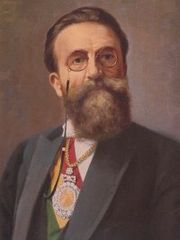
José Gutiérrez
Encyclopedia

Sucre
Sucre, also known historically as Charcas, La Plata and Chuquisaca is the constitutional capital of Bolivia and the capital of the department of Chuquisaca. Located in the south-central part of the country, Sucre lies at an elevation of 2750m...
1869 – Antofagasta
Antofagasta
Antofagasta is a port city in northern Chile, about north of Santiago. It is the capital of Antofagasta Province and Antofagasta Region. According to the 2002 census, the city has a population of 296,905...
, Chile
Chile
Chile ,officially the Republic of Chile , is a country in South America occupying a long, narrow coastal strip between the Andes mountains to the east and the Pacific Ocean to the west. It borders Peru to the north, Bolivia to the northeast, Argentina to the east, and the Drake Passage in the far...
, 1929 ) was President of Bolivia
Bolivia
Bolivia officially known as Plurinational State of Bolivia , is a landlocked country in central South America. It is the poorest country in South America...
between 1917 and 1920.
The scion of an aristocratic family from Chuquisaca which traced descent from eminent judges of the Audiencia of Charcas, he was sent to England at an early age to receive the best education possible. On his mother's side, he was related to British statesman Lord Palmerston. He later returned to Bolivia, where he worked in banking. An economist by training, he entered politics almost against his will. In 1914, he was elected deputy (representative) from La Paz
La Paz
Nuestra Señora de La Paz is the administrative capital of Bolivia, as well as the departmental capital of the La Paz Department, and the second largest city in the country after Santa Cruz de la Sierra...
. His rise was meteoric, however, as he was tipped to succeed Ismael Montes
Ismael Montes
Ismael Montes Gamboa was a Bolivian general and political figure. He served as the President of Bolivia between 1904 and 1909 and again between 1913 and 1917....
as Liberal party candidate in the 1917 presidential elections. Having won at the polls, he took office but faced severe problems stemming from worsening economic conditions and mounting opposition from the recently-formed Republican party. The 1917 assassination (never fully explained) of the founder of that party and former president, José Manuel Pando
José Manuel Pando
José Manuel Inocencio Pando Solares was President of Bolivia between October 1899 and August 1904. Born in Luribay , he studied medicine, joined the army during the War of the Pacific against Chile , and later dedicated himself to exploring his country's vast and thinly populated lowland forests...
, further undermined Gutiérrez-Guerra's popularity and legitimacy. Worse, the latter failed to act decisively from the point of view of the regime's opponents, despite his call on Congress to launch an official investigation into the alleged excesses and misdeeds of his predecessor and political chief, Ismael Montes
Ismael Montes
Ismael Montes Gamboa was a Bolivian general and political figure. He served as the President of Bolivia between 1904 and 1909 and again between 1913 and 1917....
. Twenty-plus years of unbroken Liberal control of the government (the longest by one party in the history of Bolivia) had fatigued most Bolivians and turned them against the ruling elites and their methods, and earned the red-bearded, green-eyed head of state of this Andean nation, where the majority of people are Indian, the nickname "the last Oligarch."
All of this culminated in the 1920 coup d'état which, with military help, brought to power the opposition Republican party under the leadership of Bautista Saavedra
Bautista Saavedra
Rosa Bautista Saavedra Mallea was President of Bolivia, first as part of a governing junta between 1920–21, and then as constitutionally-elected President of the Republic between 1921 and 1925....
. Gutierrez-Guerra sought refuge in the U.S. embassy and, exiled to Chile, lived the rest of his days there, dying in Antofgasta in the year 1929.
Source
Parker, William Belmont, "Bolivians of to-day", Hispanic Society of America - 1922, pp. 141-144.Benavides, Julio M., "José Gutiérrez Guerra en nuestra historia económica" 1975.
Ovidio Urioste, Mi historia anecdótica de Bolivia (1951).

